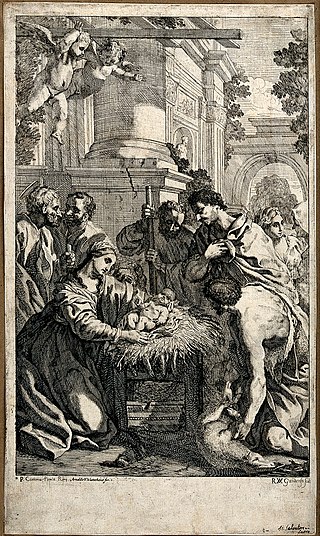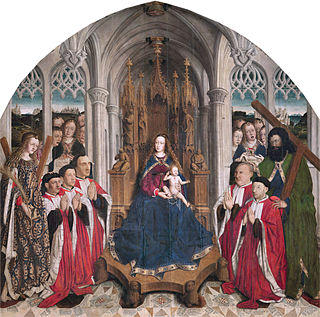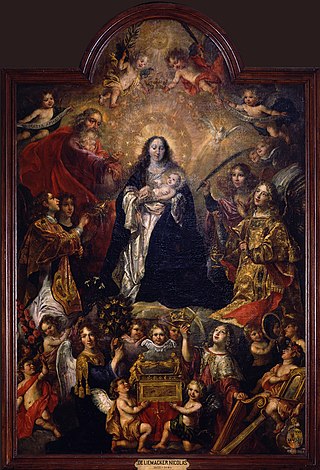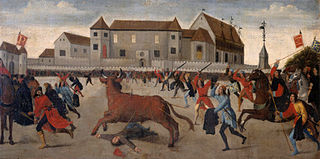Related Research Articles

Ghent is a city and a municipality in the Flemish Region of Belgium. It is the capital and largest city of the East Flanders province, and the third largest in the country, exceeded in size only by Brussels and Antwerp. It is a port and university city.

The De Vriendt brothers, Juliaan Joseph (1842–1935) and Albrecht François Lieven (1843–1900), were Belgian painters, both born at Ghent, sons of a decorative painter.
Lucas de Heere was a Flemish painter, poet and writer. His costume books and portraits are a valuable resource in depicting 16th-century clothing.

Cinema of Belgium refers to the film industry based in Belgium. Belgium is essentially a bi-lingual country divided into the Flemish (Dutch-speaking) north and the French-speaking south. There is also a small community of German speakers in the border region with Germany. Belgium is further a federal country made up of three regions and three language communities . Due to these linguistic and political divisions it is difficult to speak of a national, unified Cinema of Belgium. It would be more appropriate to talk about Flemish or Dutch-language cinema of Belgium and Walloon or French-language cinema of Belgium.

Peter de Witte, known in Italy as Pietro Candido and in Bavaria as Peter Candid was a Flemish-born Mannerist painter, tapestry designer and draughtsman active in Italy and Bavaria. He was an artist at the Medici court in Florence and at the Bavarian court of Duke William V and his successor Maximilian I in Munich.

Saint Livinus (c. 580 – 12 November 657), also Livinus of Ghent, was an apostle in Flanders and Brabant, venerated as a saint and martyr in Catholic tradition and more especially at the Saint Bavo Chapel, Ghent. His feast day is 12 November.

Robert van Audenaerde or Ouden-Aerd (1663–1748) was a Flemish painter and engraver.

Lievin Cruyl or Lieven Cruyl was a Flemish priest and a draughtsman and etcher of landscapes, seascapes, and architectural views. The drawings and etchings he made during his extended stays in Italy and Paris contributed to the development of the topographical views known as veduta.

Lluís Dalmau was a valencian 15th-century painter who flourished between 1431 and 1460. He was active in Barcelona from 1428 to 1460 and served the king of Spain in an official capacity. In 1431, King Alfonso V sent him to Flanders to learn the language of realist painting. He made a copy of the Adoration of the Lamb by Hubert and Jan van Eyck; in 1432, this was placed in St Bavo's Cathedral, Ghent. The next year, he had returned to Barcelona. In 1443, Dalmau was commissioned to paint the Virgin of the Consellers altarpiece for the chapel of the City Hall, which he completed in 1445; this is perhaps the only known work of his to survive. In 1445, he also painted a Virgin and Child in the style of Jan van Eyck, which is in the church of San Miguel at Barcelona.
Angelus "Ange" de Baets was a Belgian painter of portraits and architectural subjects. He was born at Everghem in 1793. He executed a great number of pictures, most of them views in Ghent and its environs, which are much esteemed. He died at Ghent in 1855.

Émile Pierre Joseph De Cauwer was a painter of architectural subjects. He was a pupil of his father, Joseph De Cauwer. He painted careful, detailed studies of buildings, amongst them the Church of St. Martin at Oudenarde, the Town Hall at Oudenarde, and the New Synagogue at Berlin. He died at Berlin in 1873.

Nicolaas Liemaker, or de Liemaker, de Liemaeckere, surnamed Roose, or Nicolaes Roose, a Flemish historical painter, was born at Ghent in 1601. He was the son of Jacob De Liemaker, a painter upon glass, and is said by Descamps to have been a pupil of Markus Geeraerts the younger, but as the latter joined his father in London in 1580, it is most likely that he studied under Otto van Veen at Antwerp. He attained high rank in his profession, and in 1625 returned to Ghent, where he died in 1646. The Museum of Ghent and the churches of that city and of other towns of Flanders possess a great number of his works. His best picture is the 'Consecration of St. Nicholas, Bishop of Myra,' which is above the high altar of the church of St. Nicholas at Ghent.

Pieter-Frans De Noter was a Flemish painter of landscapes and interiors.

Joseph-François Ducq, a Flemish historical and portrait painter, was born at Ledeghem in 1763. He studied at Bruges, and then under Suvée in Paris, where he obtained the second grand prize in 1800, and a medal in 1810. He also spent a considerable time in Italy, but returned to Bruges in 1815, and became a professor in the Academy. He died at Bruges in 1829. Amongst his chief works are:

Lieven van Lathem (1430–1493), was an Early Netherlandish painter and manuscript illuminator.
De Witte or Dewitte is Dutch and Flemish for "The White" and may refer to:

Jacob van Laethem, also Jacques van Lathem or Laethem, (1470–1528) was a Flemish painter of the Early Netherlandish painting era.

Drongen Abbey, or the Old Abbey, Drongen, is a monastic complex on the River Leie in Drongen, a part of the city of Ghent in East Flanders, Belgium.

Johannes Lievens, Latinized Johannes Livineius (1546/47–1599), was a scholar of Greek patristics from the Habsburg Netherlands.
Lieven is a Dutch language masculine given name. A Germanic name, it derives from Lief-win, meaning "dear friend". The name was popular in the Low Countries through the Anglo-Saxon missionary Liafwin who died around 775 in Deventer. Veneration of Saint Livinus of Ghent, who was probably invented in the 10th or 11th century and modeled after Lebuinus, made the name popular in Flanders and especially Ghent. Alternative spellings are Lieve, Lievin and the French-appearing Liévin. People with the name include:
References
- Lieven de Witte at the RKD database.
Attribution:
 This article incorporates text from a publication now in the public domain : Bryan, Michael (1886). "De Witte, Lieven". In Graves, Robert Edmund (ed.). Bryan's Dictionary of Painters and Engravers (A–K). Vol. I (3rd ed.). London: George Bell & Sons.
This article incorporates text from a publication now in the public domain : Bryan, Michael (1886). "De Witte, Lieven". In Graves, Robert Edmund (ed.). Bryan's Dictionary of Painters and Engravers (A–K). Vol. I (3rd ed.). London: George Bell & Sons.